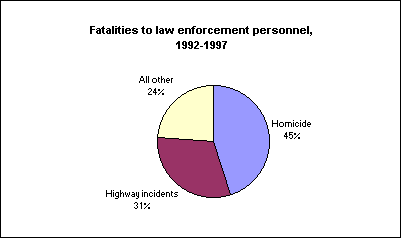An official website of the United States government
 United States Department of Labor
United States Department of Labor
Almost 150 police officers died from injuries on the job each year, on average, from 1992 through 1997. Homicides and highway crashes contributed to three-quarters of these fatalities. Other transportation incidents including helicopter crashes and being struck by vehicles were the next most common events leading to a fatality.

[Chart data—TXT]
The rate of fatal workplace injuries to police officers and other law enforcement personnel averaged about 14 per 100,000 employed for the period 1992-97, compared to an average rate of 5 per 100,000 employed for all occupations. The fatality rate for law enforcement was fairly stable over the 6-year period. In 1995, however, the rate increased to almost 17 fatalities per 100,000 employed, due in part to the deaths of 14 police officers in the Oklahoma City bombing. Then, in 1996 the rate dropped to a low of just under 11 fatalities per 100,000 workers.
These data are a product of the BLS Safety and Health Statistics Program. Additional information is available in "Fatalities to Law Enforcement Officers and Firefighters, 1992-97" (PDF 43K), Compensation and Working Conditions, Summer 1999.
Bureau of Labor Statistics, U.S. Department of Labor, The Economics Daily, How risky is police work? at https://www.bls.gov/opub/ted/1999/jun/wk5/art05.htm (visited October 25, 2025).

